 I have begun a covert operation in my home and with my family. I have named it Operation M.O.R.E. for More Oxytocin Release Events (MORE). I have left the operation covert at the time so I can assess the impact of my actions. After the initial evaluation, I plan on taking this operation public and including the whole family in Operation MORE. The purpose of Operation MORE is to increase the number of events that will release oxytocin in various family members. Why have I chosen to do this? Research suggests that:
I have begun a covert operation in my home and with my family. I have named it Operation M.O.R.E. for More Oxytocin Release Events (MORE). I have left the operation covert at the time so I can assess the impact of my actions. After the initial evaluation, I plan on taking this operation public and including the whole family in Operation MORE. The purpose of Operation MORE is to increase the number of events that will release oxytocin in various family members. Why have I chosen to do this? Research suggests that:
- Oxytocin promotes attachment and bonding. It helps create M.O.R.E. intimacy in relationships.
- Oxytocin helps to reduce feelings of stress. We live in a stressful world. If oxytocin release can help relieve stress, we might as well have M.O.R.E.
- Oxytocin seems to intensify men’s fond memories of their mother and decrease negative memories. Perhaps more oxytocin in general will help produce M.O.R.E. fond memories of family in general.
- Oxytocin can intensify the bond between sexual partners. Even more, it promotes faithfulness between spouses. Men who had received a nasal spray of oxytocin were less responsive to women other than their wife…they became M.O.R.E. singly focused on their wife.
- Oxytocin inhibits tolerance to addictive drugs and reduces withdrawal symptoms. In other words, a steady release of oxytocin will decrease the likelihood of drug abuse.
- Oxytocin seems to improve a person’s ability to interact M.O.R.E. with others (study done with children who had autism).
- Oxytocin triggers “defensive aggression” against outside threats. In other words, it helps promote our instinct to become M.O.R.E. protective of those we love.
- Oxytocin counters the effect of stress hormones (cortisol) and, as a result, will promote “M.O.R.E. better” sleep.
- Oxytocin fosters generosity. In one study, those who received a nasal spray of oxytocin were 80% M.O.R.E. generous than those receiving a placebo.
That is enough reason to increase the oxytocin flow in the family and begin Operation MORE. Here is the plan of action, the ways to complete this covert operation and produce MORE oxytocin:
 Hug family members for at least 10 seconds. Do it at least once a day, maybe even M.O.R.E.
Hug family members for at least 10 seconds. Do it at least once a day, maybe even M.O.R.E.- When the opportunity arises, hold a family members hand with one hand over the other, make eye contact with them, and give them a compliment.
- Watch an “emotionally compelling movie” (AKA—a chick flick). I know it is a sacrifice to watch chick flicks with the family, but research suggests a 47% surge in oxytocin (that’s 47% M.O.R.E.) while watching an “emotionally compelling movie.” Sometimes we have to make sacrifices in our covert operation to enhance family intimacy.
- Sing. That’s right. Singing helps release M.O.R.E. oxytocin. Encourage your family to sing.
- Dance. One study found oxytocin increased by 11% after dancing (dance M.O.R.E.).
- Do something exciting or thrilling. Have an adventure–anything from a roller coaster ride to watching a scary movie. Enjoy a thrill together.
- Laugh together.
- Go for a walk. To make this even more powerful, hold hands while going for a walk and have an open, transparent conversation while you do.
So far, Operation MORE has proven successful in my home. I have noticed M.O.R.E. laughter, M.O.R.E. intimacy, and M.O.R.E. joy in our interactions. In fact, the success has proven so dramatic that I have chosen to take Operation More public in my home. Perhaps you can join us by starting Operation MORE in your home as well.

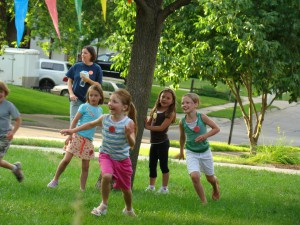
 One of the best ways for me to recall my goals and direction is through writing. So, I want to use this blog to remind myself about what it means to practice honor, grace, and celebration in the family; and, why I write blogs for Honor Grace Celebrate. Hopefully, as I write this reminder we will all be reminded to practice honor, grace, and celebration in our family…after all, I truly believe that when families practice honor, grace, and celebration they find greater family intimacy and joy. I also believe God designed the family to be a place of honor, grace, and celebration. So what does honor, grace, and celebration have to do with family?
One of the best ways for me to recall my goals and direction is through writing. So, I want to use this blog to remind myself about what it means to practice honor, grace, and celebration in the family; and, why I write blogs for Honor Grace Celebrate. Hopefully, as I write this reminder we will all be reminded to practice honor, grace, and celebration in our family…after all, I truly believe that when families practice honor, grace, and celebration they find greater family intimacy and joy. I also believe God designed the family to be a place of honor, grace, and celebration. So what does honor, grace, and celebration have to do with family? 
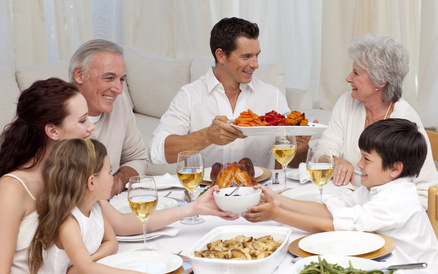 longer had those family dinners. Even as a middle school boy, he missed family dinners. Family dinners provided him the time he desired to reconnect with his family…to slow down, talk, and connect with his whole family. I have to admit, I was somewhat surprised to hear a middle-school-aged child talking about missing family dinners because of the family connection he desired. Nonetheless, he made an excellent observation. Family dinners provide a great time to reconnect and bond with our families. They are a time to relax, tell stories, and talk about our daily lives, laugh, and even make some future plans. Research also indicates that having regular family meals help to reduce the rates of substance abuse, teen pregnancy and depression in adolescents. Families that enjoy regular family meals see their children attain higher grade-point averages than children whose families do not have regular family meals. Studies also suggest that “dinner conversation” boosts vocabulary more than reading does! The stories of personal victories, perseverance, fun moments, and family times help build a child’s resilience and confidence. As you can see, family meals offer a smorgasbord of benefits for families and their children. So, if you want your family to grow more intimate…if you want your children to grow up happy…if you want your children to grow up physically and emotionally healthy…if you want your children to have a higher grade-point average, set aside the time to enjoy regular family meals. Here are a few tips to help you plan your family meal time:
longer had those family dinners. Even as a middle school boy, he missed family dinners. Family dinners provided him the time he desired to reconnect with his family…to slow down, talk, and connect with his whole family. I have to admit, I was somewhat surprised to hear a middle-school-aged child talking about missing family dinners because of the family connection he desired. Nonetheless, he made an excellent observation. Family dinners provide a great time to reconnect and bond with our families. They are a time to relax, tell stories, and talk about our daily lives, laugh, and even make some future plans. Research also indicates that having regular family meals help to reduce the rates of substance abuse, teen pregnancy and depression in adolescents. Families that enjoy regular family meals see their children attain higher grade-point averages than children whose families do not have regular family meals. Studies also suggest that “dinner conversation” boosts vocabulary more than reading does! The stories of personal victories, perseverance, fun moments, and family times help build a child’s resilience and confidence. As you can see, family meals offer a smorgasbord of benefits for families and their children. So, if you want your family to grow more intimate…if you want your children to grow up happy…if you want your children to grow up physically and emotionally healthy…if you want your children to have a higher grade-point average, set aside the time to enjoy regular family meals. Here are a few tips to help you plan your family meal time: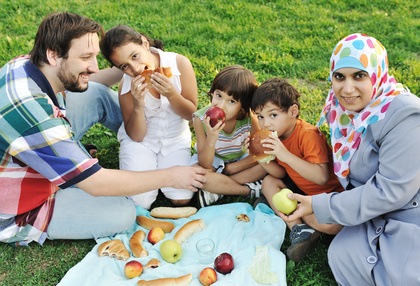 another time and focus on conversation that will build relationships. You can talk about the day’s activities, each person’s dreams, memories of fun family times, and things you’d like to do in the future. Really, the topics available for conversation are limited only by our imagination. If you have trouble thinking of topics, check out these
another time and focus on conversation that will build relationships. You can talk about the day’s activities, each person’s dreams, memories of fun family times, and things you’d like to do in the future. Really, the topics available for conversation are limited only by our imagination. If you have trouble thinking of topics, check out these 
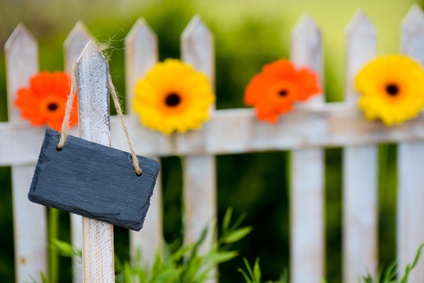 celebrate one another’s strengths, and honor someone who has contributed to your family success. It does take a little planning, but even the planning can be fun.
celebrate one another’s strengths, and honor someone who has contributed to your family success. It does take a little planning, but even the planning can be fun.  Third, design your Beautiful Family Day. Consider what you will eat (pick something from each person’s favorites food list), what you will do (pick something from each person’s favorite activities list), and when you will begin. As you plan, include at least three things. Include a way for each family member to use one of their strengths in contributing to the day. Perhaps one person enjoys cooking and can cook a special dish for the family. One person may enjoy music and could perform a song for the family. You get the idea. Also include time to visit the person for whom you wrote the testimonial. Perhaps you can meet them for coffee or invite them to your home for dessert. Plan to present the testimonial to them (perhaps read it to them) and prepare a copy for them to keep. Finally, include at least one activity that will benefit someone outside your family. You might “Run for the Cure,” sing for 30-minutes at a nursing home, take a child you know on one of your activities, or buy a gift for a shut-in while you’re out. Use your imagination to think of what you might do to benefit someone outside your family.
Third, design your Beautiful Family Day. Consider what you will eat (pick something from each person’s favorites food list), what you will do (pick something from each person’s favorite activities list), and when you will begin. As you plan, include at least three things. Include a way for each family member to use one of their strengths in contributing to the day. Perhaps one person enjoys cooking and can cook a special dish for the family. One person may enjoy music and could perform a song for the family. You get the idea. Also include time to visit the person for whom you wrote the testimonial. Perhaps you can meet them for coffee or invite them to your home for dessert. Plan to present the testimonial to them (perhaps read it to them) and prepare a copy for them to keep. Finally, include at least one activity that will benefit someone outside your family. You might “Run for the Cure,” sing for 30-minutes at a nursing home, take a child you know on one of your activities, or buy a gift for a shut-in while you’re out. Use your imagination to think of what you might do to benefit someone outside your family. 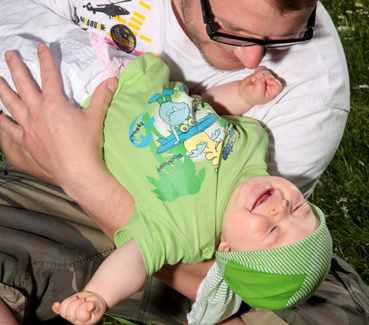 my best sing-song voice. When the “tickle monster” made a slight movement in my daughter’s direction, she curled into a ball, grabbed her stomach and started to giggle. The “tickle monster” then swooped toward her belly and tickled her. She laughed hysterically, a contagious laugh that made several other people in the room laugh, too. I tried to end our game, but she took my hand and put it on her stomach. She wanted to continue.
my best sing-song voice. When the “tickle monster” made a slight movement in my daughter’s direction, she curled into a ball, grabbed her stomach and started to giggle. The “tickle monster” then swooped toward her belly and tickled her. She laughed hysterically, a contagious laugh that made several other people in the room laugh, too. I tried to end our game, but she took my hand and put it on her stomach. She wanted to continue.  family gatherings with joyful anticipation. If you want to have that kind of family, there are two things you need to know. First, a joyful family has a history. They have memories of joyful times. Joyful families have intentionally created opportunities to enjoy one another’s company and build joyful memories with family. They may have built joyful memories by playing games with one another or going on day trips with one another. Perhaps they shared adventures or went on vacations (long ones or short ones) together. Their joyful moments may have been as simple as sharing a favorite song on the radio or a funny story about the day…or as complex as learning a new skill together. The family of joy may have built joyful memories on small things or big things…either way they intentionally seized opportunities to experience fun and joy as a family. This history of family fun grows stronger and more secure as they share pictures of their fun times together and retell the stories of their joyful history. Whatever they found joyful, they shared. Whatever joyful moments they shared created a history of joy; and that history of joy became a foundation of trust and anticipation upon which to build new joyful moments.
family gatherings with joyful anticipation. If you want to have that kind of family, there are two things you need to know. First, a joyful family has a history. They have memories of joyful times. Joyful families have intentionally created opportunities to enjoy one another’s company and build joyful memories with family. They may have built joyful memories by playing games with one another or going on day trips with one another. Perhaps they shared adventures or went on vacations (long ones or short ones) together. Their joyful moments may have been as simple as sharing a favorite song on the radio or a funny story about the day…or as complex as learning a new skill together. The family of joy may have built joyful memories on small things or big things…either way they intentionally seized opportunities to experience fun and joy as a family. This history of family fun grows stronger and more secure as they share pictures of their fun times together and retell the stories of their joyful history. Whatever they found joyful, they shared. Whatever joyful moments they shared created a history of joy; and that history of joy became a foundation of trust and anticipation upon which to build new joyful moments.  star.” It all started when my children were little and could not pronounce “twinkle.” Instead, it came out as “tinkle.” Being the loving father I am, I rewrote the lyrics so “tinkle” would fit. My wife was less than pleased when my daughters sang “tinkle, tinkle little star, please don’t tinkle on my arm; up above the world so high, please don’t tinkle in my eye.” Well…in my defense, I didn’t think the words would stick. And, they did eventually learn the “correct words” to the song. That became evident when a kamikaze bird did a nose dive into our picture window. My youngest daughter found the bird after it had sacrificed his life in that last heroic dive into our picture window. She took me to the bird and informed me that we needed to give it a proper burial. So, with the dignity becoming such a heroic act, we gathered the bird (feathers and all) and led a procession into the flower garden. After painstakingly preparing a final resting place for our new found friend, we carefully laid him to rest and covered him with dirt “from which we come.” Throughout this process, my daughter squatted near the grave like a catcher. With a final pat of the shovel on the covered grave, she stood up and solemnly placed her hand on her heart as she sang the dignified chorus of “Twinkle, twinkle little star…” and we paid our final respects to the lost bird. At least she sang the “twinkle, twinkle” version.
star.” It all started when my children were little and could not pronounce “twinkle.” Instead, it came out as “tinkle.” Being the loving father I am, I rewrote the lyrics so “tinkle” would fit. My wife was less than pleased when my daughters sang “tinkle, tinkle little star, please don’t tinkle on my arm; up above the world so high, please don’t tinkle in my eye.” Well…in my defense, I didn’t think the words would stick. And, they did eventually learn the “correct words” to the song. That became evident when a kamikaze bird did a nose dive into our picture window. My youngest daughter found the bird after it had sacrificed his life in that last heroic dive into our picture window. She took me to the bird and informed me that we needed to give it a proper burial. So, with the dignity becoming such a heroic act, we gathered the bird (feathers and all) and led a procession into the flower garden. After painstakingly preparing a final resting place for our new found friend, we carefully laid him to rest and covered him with dirt “from which we come.” Throughout this process, my daughter squatted near the grave like a catcher. With a final pat of the shovel on the covered grave, she stood up and solemnly placed her hand on her heart as she sang the dignified chorus of “Twinkle, twinkle little star…” and we paid our final respects to the lost bird. At least she sang the “twinkle, twinkle” version. 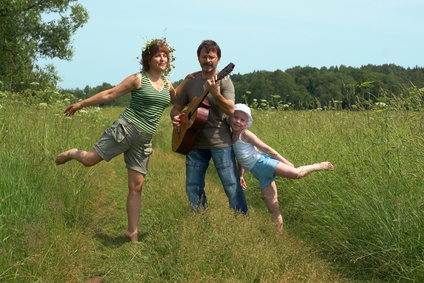 the sacculus in the inner ear, which brings immediate enjoyment. It releases oxytocin, helping to form a bond of trust and empathy among those involved. Singing together also helps people cope with difficulties, even tragedies. It builds resilience and helps us successfully navigate those tragic moments of life. So, we often sing at funerals. When terrorists struck the U.S. on 9/11 or when we witnessed the tragedy of a senseless school shooting, people came together and sang as part of the healing process.
the sacculus in the inner ear, which brings immediate enjoyment. It releases oxytocin, helping to form a bond of trust and empathy among those involved. Singing together also helps people cope with difficulties, even tragedies. It builds resilience and helps us successfully navigate those tragic moments of life. So, we often sing at funerals. When terrorists struck the U.S. on 9/11 or when we witnessed the tragedy of a senseless school shooting, people came together and sang as part of the healing process. 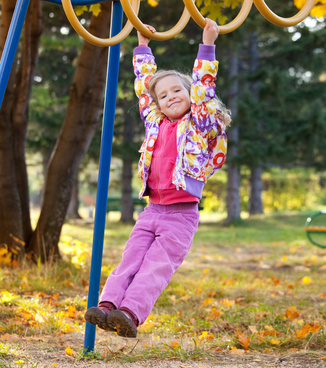
 Find one or two other families to share this event with and let each family start in their own home at a set time. Show the first picture to your family and figure out what it represents. Then, race to get there. At each location, spend time with your family and any other family that might have arrived. Look at some books together. Play catch. Check out the animals at the zoo. Order and eat your favorite appetizer. Talk about the day, your life, and your dreams. Tell jokes. Have fun.
Find one or two other families to share this event with and let each family start in their own home at a set time. Show the first picture to your family and figure out what it represents. Then, race to get there. At each location, spend time with your family and any other family that might have arrived. Look at some books together. Play catch. Check out the animals at the zoo. Order and eat your favorite appetizer. Talk about the day, your life, and your dreams. Tell jokes. Have fun.